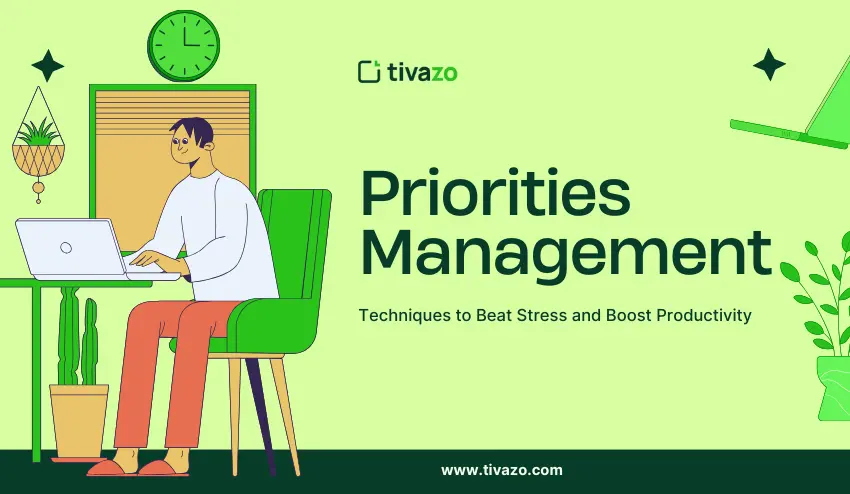Consider waking up with 50 tasks crying for your attention. Emails, projects, deadlines, personal goals — all competing for your attention at once. If you don’t have a solid structure for Priorities management, you’ll be busy, but not productive.
Priorities management isn’t just about to-do lists; it’s about ensuring your actions align with what is truly important in business, career, and life. This article will provide you with proven frameworks, tools, and psychological tricks to help you focus, execute, and succeed.
Key Highlights:
- Priorities Management definition
- You Can’t Succeed Without Priorities Management
- Priorities Management Techniques
- Tools That Support Priorities Management
- Mistakes in Priorities Management
- Comparison of Priorities Management for Teams and Individuals
- Turn Prioritization into a Daily Habit
- Future Trends in Prioritization
What Is Priorities Management (and Why It Matters)?
Definition:
Priorities management is the process of identifying, organizing, and taking action on tasks in order to establish urgency, importance, and long-term impact. Rather than simply trying to do everything at once, priority management helps you use your brain to focus on what is actually creating progress.
Why it matters:
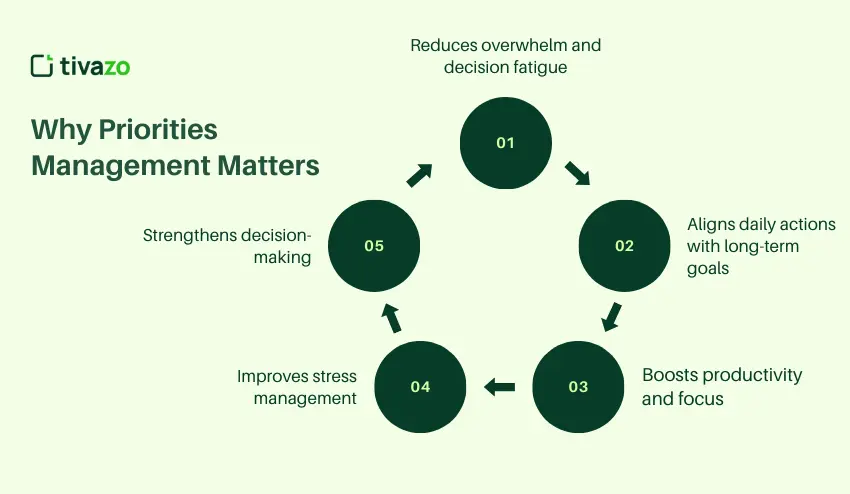
- Reduces overwhelm and decision fatigue – By filtering out what does not matter, you conserve brain energy and do not get lost in never-ending to-do lists.
- Aligns daily actions with long-term goals – The intended outcome of every task you check off your list is to take you a step closer to your larger vision instead of just being “busy”.
- Boosts productivity and focus – If you know the three top priorities you need to accomplish each day, you will spend less time bouncing around to different tasks and more time actually making progress.
- Improves stress management – When you are clear about what deserves your attention, it creates a feeling of control and reduces anxiety at work or home.
- Strengthens decision-making – Priorities management provides a clear framework for saying yes to what matters and saying no to distractions.
In essence, priority management is the difference between being productive and busy. It helps ensure that your efforts convert into meaningful results: whether it is completing a project on time, growing your business, or simply managing balance in your life.
Why You Can’t Succeed Without Priorities Management
Success is not about having more time; it is about using time effectively. With no clear priorities, you can only react to whatever feels urgent, and you can end up multitasking, creating stress, and wasting effort. Priorities management helps you stay focused on high-payoff work while alleviating burnout.
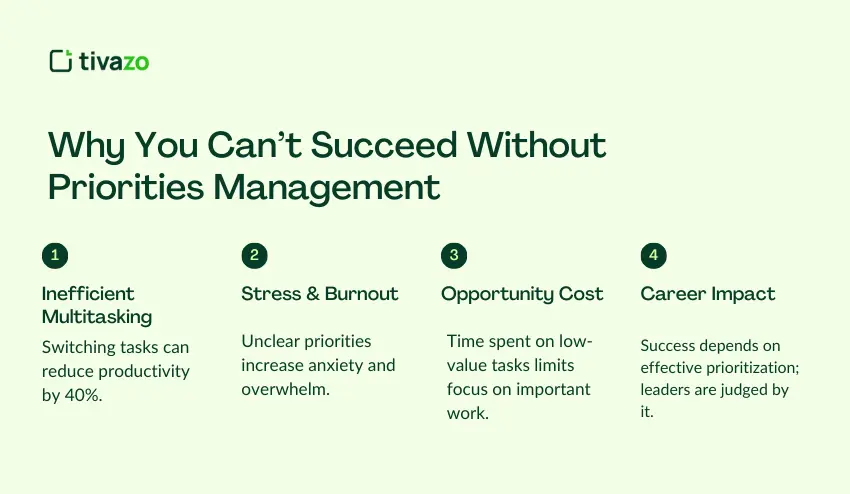
- Inefficient multitasking: Studies show that task switching affects productivity by 40%; in other words, your performance suffers.
- Stress and burnout: When things are not clear, anxiety rises.
- Opportunity cost: Each minute that you spend on lower-value tasks detracts from the time you have for something more meaningful.
- Career impact: Leaders and entrepreneurs must prioritize; they are judged on their ability to do so. They are judged by how well they prioritize.
7 Proven Priorities Management Techniques (with Examples)
1. Eisenhower Matrix (Urgent vs. Important)
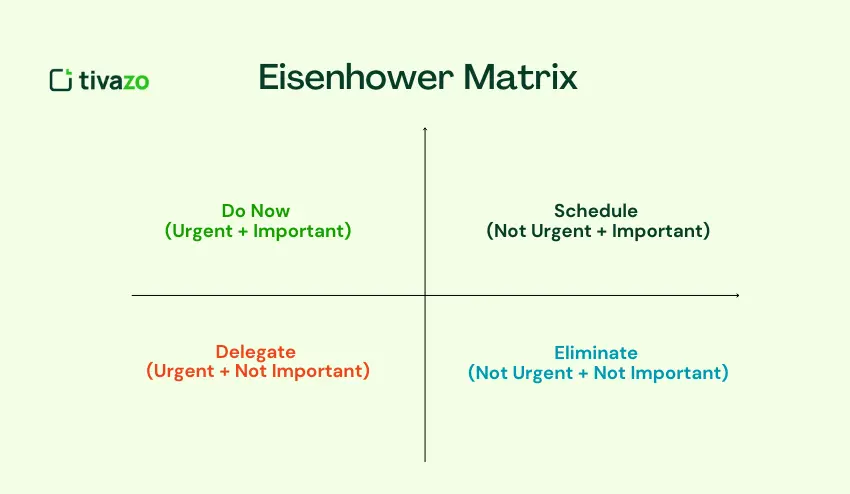
Popularized by U.S. President Dwight Eisenhower, the Eisenhower Matrix method is powerful because it forces you to differentiate between “reactive” tasks and “strategic” tasks. Most of us confuse urgency and importance, but the two are different.
- Do Now (Urgent + Important): Critical deadlines, emergencies.
- Schedule (Not Urgent + Important): Strategic planning, skill building.
- Delegate (Urgent + Not Important): Routine tasks that can be done by someone else
- Eliminate (Not Urgent + Not Important): Distractions and unnecessary time-wasters
📌 Example: A manager spends their mornings on client proposals (Important + Urgent) instead of being slave to emails (Urgent but Not Important). Over time, this creates better outcomes and less stress.
2. Pareto Principle (80/20 Rule)
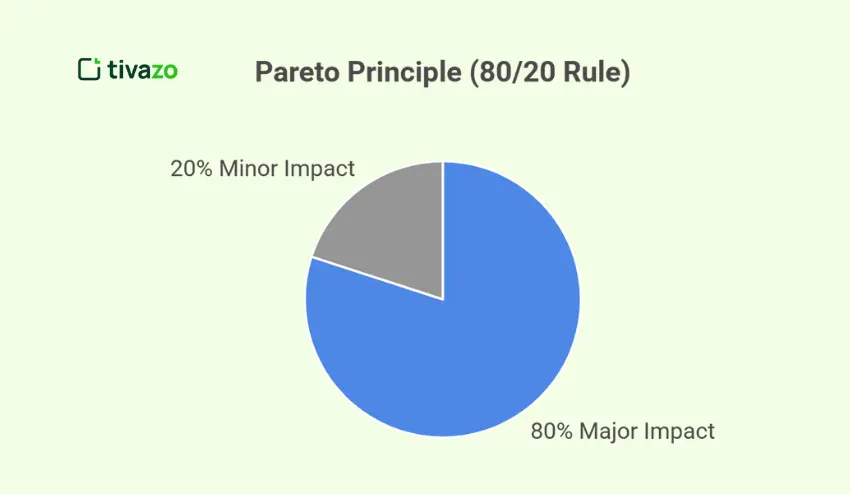
The 80/20 principle reminds us that not all tasks are created equal. Often, a small percentage of activities creates the bulk of results. The challenge is identifying which tasks create the most return on time, energy, or money – and pursuing those tasks. Just as we say, “don’t fall victim to being busy versus productive.”
📌 Example: A freelancer notices that 2 out of their 10 clients generate the majority of the income. Rather than being busy and spreading their energy out, they put additional service and time into their high-value clients.
3. Warren Buffett’s 2-List Rule
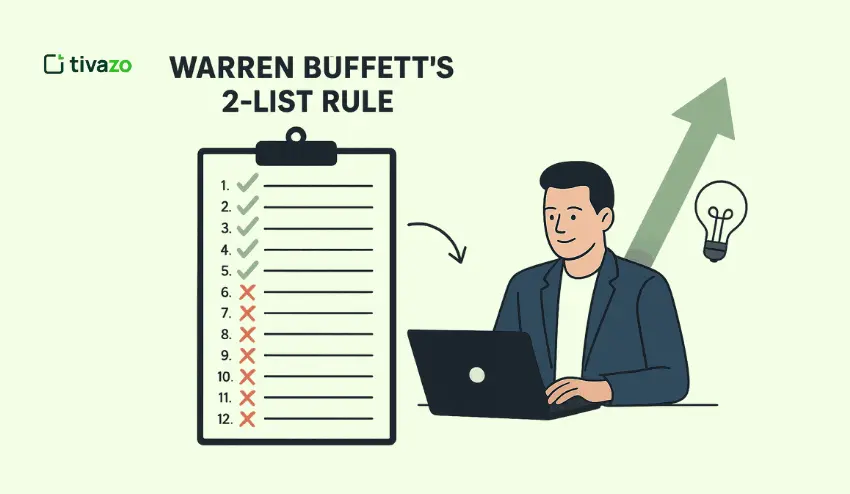
The 2-List Rule is about focus and about elimination. The hardest part of productivity is not picking what to do but picking what NOT to do. Buffett’s idea simplifies that: Write down 25 goals, select 5 goals, and the other 20 become distractions. This helps eliminate dilution of energy.
📌 Example: An entrepreneur stops getting distracted by side projects and focuses all of their efforts on scaling the one business to their vision.
4. Ivy Lee Method
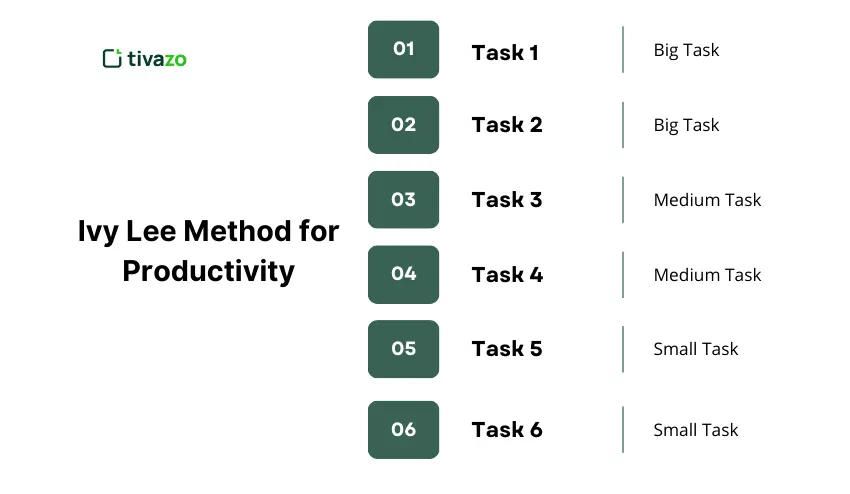
The Ivy Lee Method was created in 1918 for executives, yet is timeless. By writing down 6 important tasks at the end of the day, the morning starts clear without decision fatigue. Only using 6 tasks helps avoid feeling overwhelmed. The fixed order of priority keeps you focused.
📌 Example: A consultant ends each day writing 6 action items to be completed next. The next day, the consultant works down the list one by one. Even if 4 items were completed, progress feels visible without pushing for unattainable goals.
5. Time Blocking

Time blocking is all about controlling your schedule instead of your schedule controlling you. Assigning time blocks, whether for deep work, meetings, or admin purposes are way to respect focus and minimize context-switching. Time blocking guarantees to spend scheduled time for rest before burnout.
📌 Example: Elon Musk has scheduled 5-10 minute blocks for overseeing Tesla and SpaceX. While not everyone needs that level of detail, hourly blocks can keep distractions away and add a layer of structure.
6. Eat That Frog
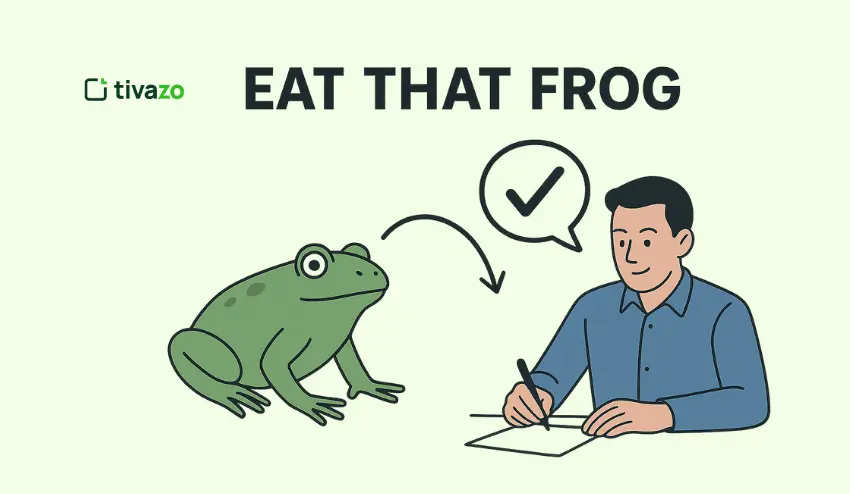
In the Eat that Frog method, “frog” is the task that you don’t want to do, but is likely the most impactful. If you tackle it when you start, you won’t have as much mental resistance, and it will set you up for a productive day. This habit trains discipline too: Once you’ve established the habit of addressing the difficult tasks in the beginning, procrastination will lose its power.
📌 Example: A marketer begins their day by creating a new campaign strategy (very impactful, but a tough task) before they check Slack or email. This way, they’re ensuring that their highest value work always gets accomplished first.
7. MoSCoW Method (Must, Should, Could, Won’t)
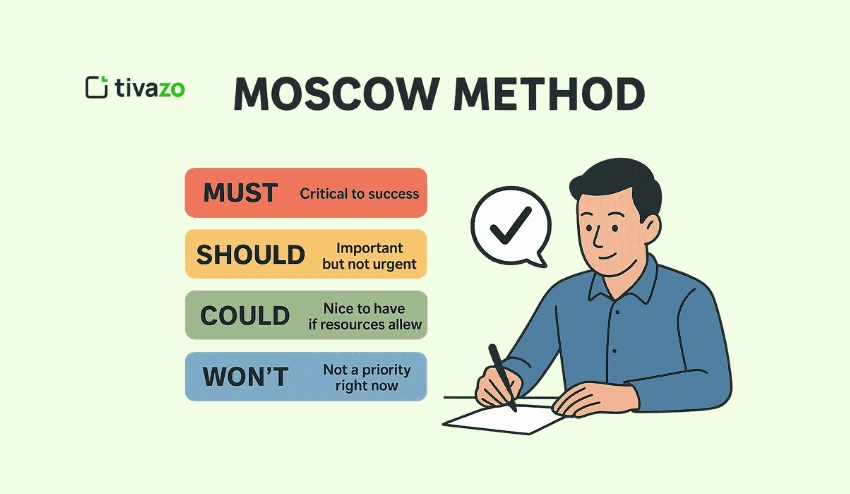
The MoSCoW method is popular in project management, but can be great for teams in time-constrained or resource-scarce situations. It forces a team to align on priorities based on labeling each task. The real power here is that it removes debates and clarifies expectations, especially for stakeholders. It’s hard to debate what is the most important task, when it is labeled as a “Must” task.
- Must: Critical to success.
- Should: Important but not urgent.
- Could: Nice to have if resources allow.
- Won’t: Not a priority right now.
📌 Example: A software team developing an app determines that login security and payment system are Musts, while a dark mode theme is a Could. This direction allows the project to stay within scope and reach completion.
Modern Tools That Support Priorities Management
Using the right tools to consider and manage your priorities can be easier and more effective. Here are some great examples of the most used methods:
- Trello / Asana → visual task boards.
- Notion → customizable workflows.
- ClickUp → time-tracking + priority flags.
- Google Calendar → time blocking.
- AI Assistants (Motion, Reclaim) → auto-schedule your priorities.
By using these tools with any prioritization methods, you are not only directed to know what is important, but you are actually taking action on what matters, consistently
Common Mistakes in Priorities Management (and Fixes)
Even with the best intentions, people often struggle with prioritization. Here are the most common mistakes and how to fix them:
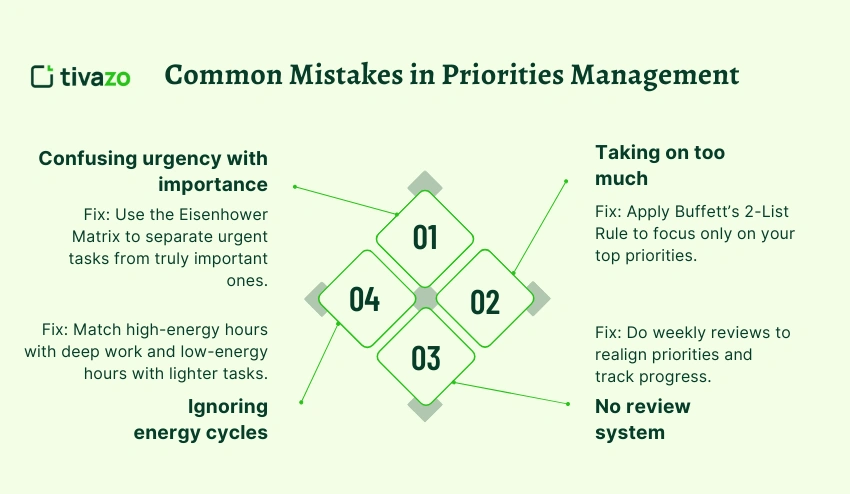
- Mistake 1: Confusing urgency with importance
Many people focus on that which seems urgent, without regard for importance.
Solution: Use the Eisenhower Matrix to help discern the difference between the level of importance of tasks and distractions.
- Mistake 2: Taking on too much
Overloading yourself diminishes your focus and increases everyone else’s stress.
Solution: Use Buffett’s 2-List Rule – focus on your top priorities and ignore the rest.
- Mistake 3: No review system
Without regular reflection, priorities can drift and progress stalls.
Fix: Perform weekly reviews to adjust tasks and track progress.
- Mistake 4: Ignoring energy cycles
When you work at lower energy levels, you decrease your efficiency and quality.
Solution: Schedule your deep work tasks around your high-energy hours and lighter work tasks at low-energy hours.
✅ If you keep yourself from making the mistakes mentioned above, you will ensure that your prioritization system actually works for you, reduce your stress, and maximize your results!
The Psychology Behind Prioritization
Prioritization isn’t simply a productivity trick it’s based on how the brain functions. The brain is facing thousands of decisions, distractions, and temptations every single day. Without a way to prioritize tasks by importance, you will likely end up stuck in mostly low-value tasks, delaying decision-making, or simply mentally exhausted. Knowing the science behind prioritization means you can build strategies in line with human engagement processes.
Here are three key psychological principles that explain why prioritization is so powerful:
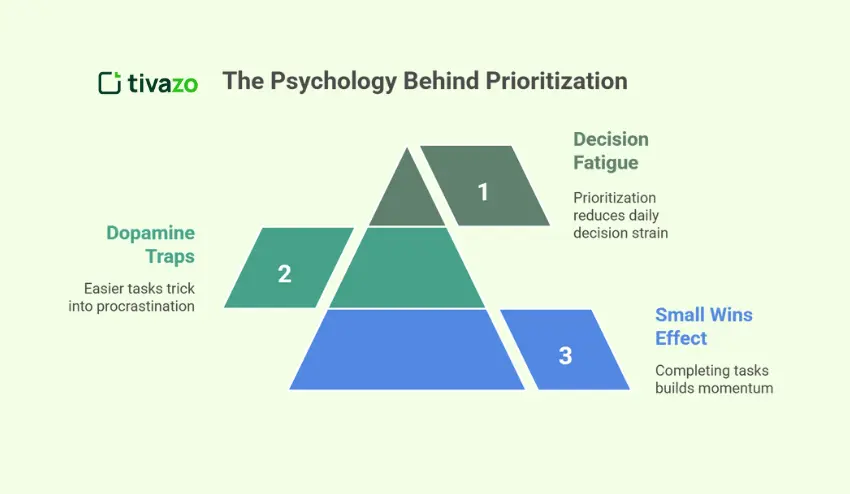
- Decision Fatigue: The brain is making 35,000 decisions every single day, and prioritization reduces that strain.
- Dopamine Traps: The dopamine release that comes from completing easier tasks tricks you into procrastination.
- Small Wins Effect: Completing one meaningful task builds momentum.
Priorities Management for Teams vs. Individuals
Differences between Priorities Management for Teams and Individuals are:
| Audience | Focus | Example |
|---|---|---|
| Individuals | Align daily tasks with personal or career goals | A freelancer prioritizes top 3 tasks each day to stay on track |
| Teams | Align group priorities to avoid conflicts | Agile teams use MoSCoW to clarify sprint tasks and responsibilities |
How to Turn Prioritization into a Daily Habit
Knowing how to prioritize is one thing; implementing it on an automatic basis is another. The most successful people do not plan on occasion, but they do make prioritizing part of their daily routine, so that it becomes automatic. Making prioritizing a habit decreases decision fatigue, allows for more high-impact work to happen every single day, and keeps longer-term goals visible.
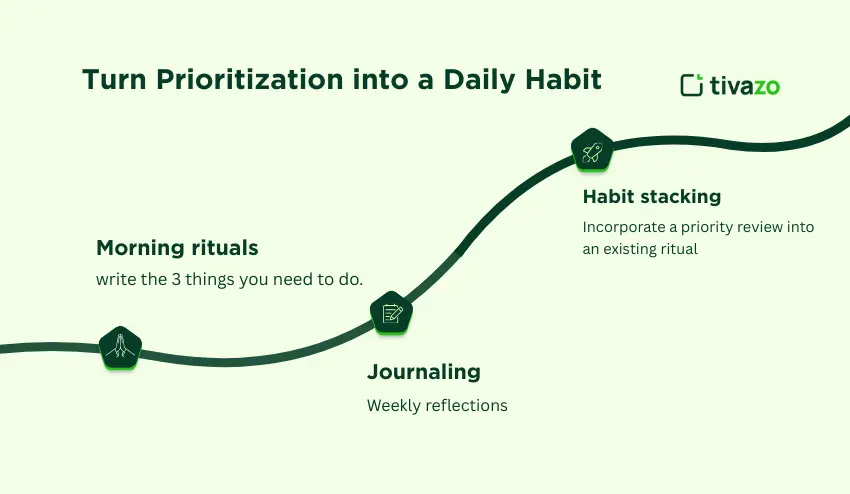
- Morning rituals: write the 3 things you need to do.
- Journaling: Weekly reflections.
- Habit stacking: Incorporate a priority review into an existing ritual (i.e.: coffee, workout).
Future Trends in Prioritization (AI & Beyond)
Prioritization management is changing rapidly, with technology and a shifting work culture. To be prepared for the future, we must keep an eye open to trends that will develop our focus and how we get things done.
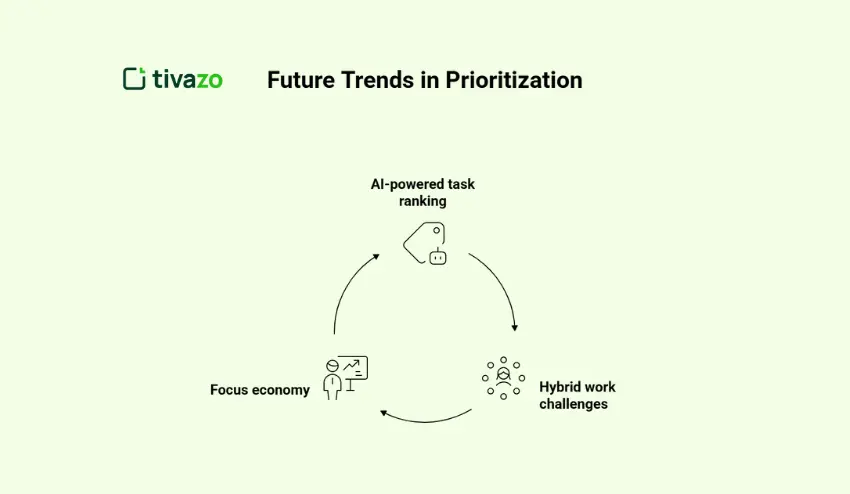
- AI-powered task ranking: A process that uses AI to analyze importance, deadlines, and rank all tasks in every day for maximum impact.
- Hybrid work challenges: We need to blend personal and professional priorities while using flexible draws for our planning and collaborative technology.
- Focus economy: Success will be measured by outcome and impact, not hours to a task; prioritization will be critically important.
Conclusion: The Power of Intentional Action
Managing priorities is more than just productivity hacks – it is a philosophy of intentional living. The leaders, entrepreneurs, and professionals who succeed are not always the busiest, but the most focused.
If you want to rule your goals, quit being reactive about everything. Determine the important things, then remove everything else, and execute.
